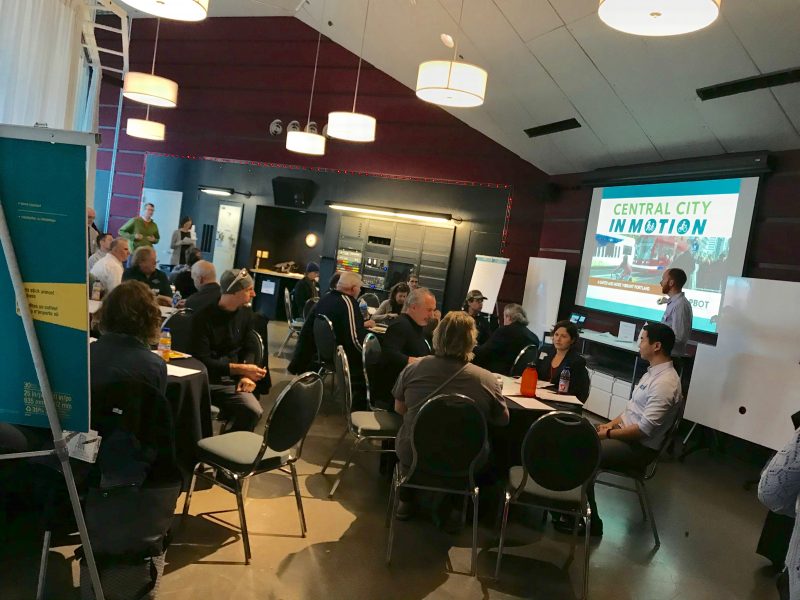
(Photos: J. Maus/BikePortland)
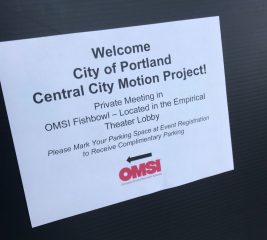
A private, invite-only meeting of Central Eastside power-brokers held on Wednesday at the Oregon Museum of Science and Industry shows just how seriously the City of Portland is taking an effort to establish a network of low-stress, “family-friendly” cycling routes throughout the Central City.
It also shows how much weight some business owners have in a planning process that’s over five years old and has yet to become open to the general public.
Before I bring you up to speed on the Central City in Motion project (formerly known as the Central City Multimodal Project), a bit of background is in order…
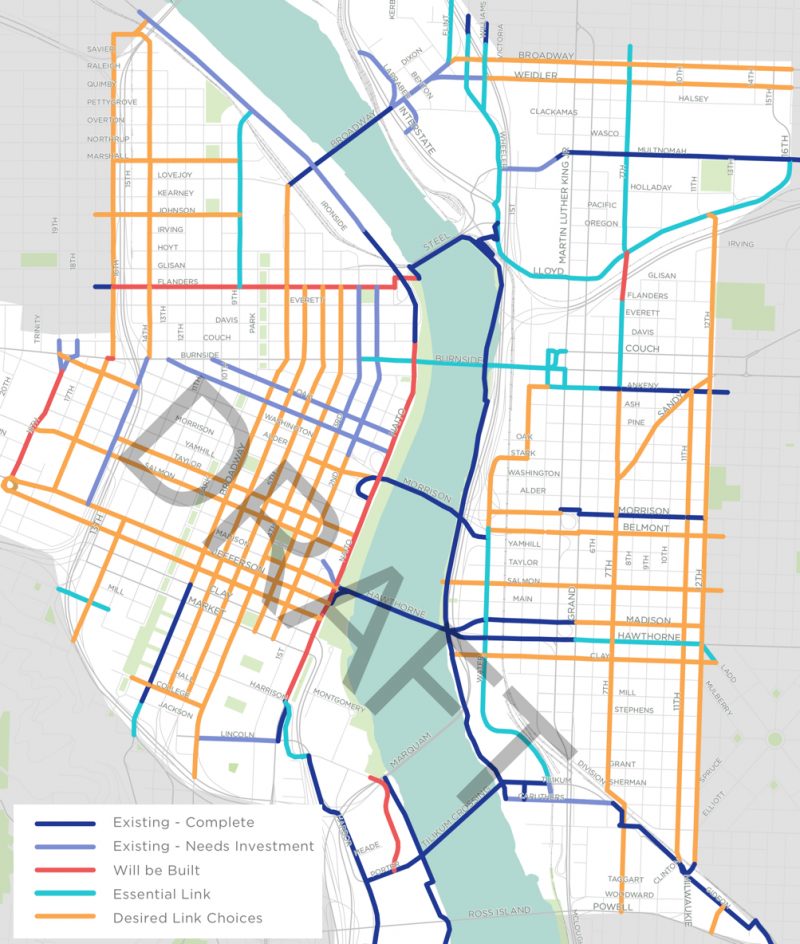
PBOT has taken a very slow road on this project. It’s been on their radar (and ours) since late 2012 and they still haven’t held a single public open house. Portland City Council voted to support the federal grant for this work in September 2013. Nearly a year later, and with not a peep from PBOT about it, The Street Trust tried to create some urgency. PBOT said they were waiting for federal funds to materialize.
By January 2015 the City was still seeking a project manager to get the planning started. By May they’d found one. With a project manager in hand, PBOT planners and downtown business leaders traveled to Copenhagen for a week-long study tour to prime the pump for future Portland projects. Seven months after they returned, in February 2016, the man hired to manage the project for PBOT says he was fired.
“A network that’s connected and coherent and designed for safety that can get kids and families and Central Eastside employees where they need to go around the district. It won’t be every street, but there will be a network and we’ll have it well-signed so you know how to get to the bridge to to downtown.”
— Katie Mangle, Alta Planning + Design
By May 2016 PBOT finally announced what appeared to be real progress. Buoyed by additional funds from the local gas tax, the City’s new project manager Gabe Graff said the $8.4 million plan would, “fill in a more comfortable and protected bicycling network.” Along with an explanation of why the project had taken so long to materialize, PBOT spokesman John Brady told us at the time that public outreach and planning would start that summer.
That didn’t happen.
The project was formally adopted by City Council in August 2016. At that time (which is the last we reported on this project) were told public outreach would begin shortly thereafter, 2017 would be spent on planning and design, and construction would begin in 2018.
That didn’t happen either.
Instead, PBOT has spent 18 months seeking feedback on the project from neighborhood groups, business organizations and city committees. Their website lists 20 presentations or meetings between June 2016 and May 2017. Of those, eight were held with groups that represent business owners including the Portland Business Alliance (who they’ve met with three times), the Central Eastside Industrial Council (CEIC), the Downtown Retail Council, and Business for a Better Portland.
In April 2017 PBOT held a design charrette focused specifically on the Central Eastside Industrial District (CEID). 17 stakeholders attended, as well as 11 PBOT staff and eight consultants from three private companies that have contracts to help with the planning.
In November of last year PBOT formed an 18-member Sounding Board charged with, “‘thinking big’ about the future of transportation in Portland’s central city,” and representing, “a broad set of community and business perspectives.” They’ve met twice since then. This Sounding Board is in addition to the 13-member Technical Advisory Committee that’s met twice since October.
All of these meetings have happened before the City has made any formal public outreach or received any feedback from the general public.
In December of last year PBOT released the result of all this input: A map showing Portland’s Central City “low-stress network” and the “desired link choices” they want to establish through this project. When you look at that map, you’ll notice a glaring lack of north-south routes through the Central Eastside.
That’s what brings me back to the meeting on Wednesday. It was a follow-up to that design charrette back in April.
Advertisement
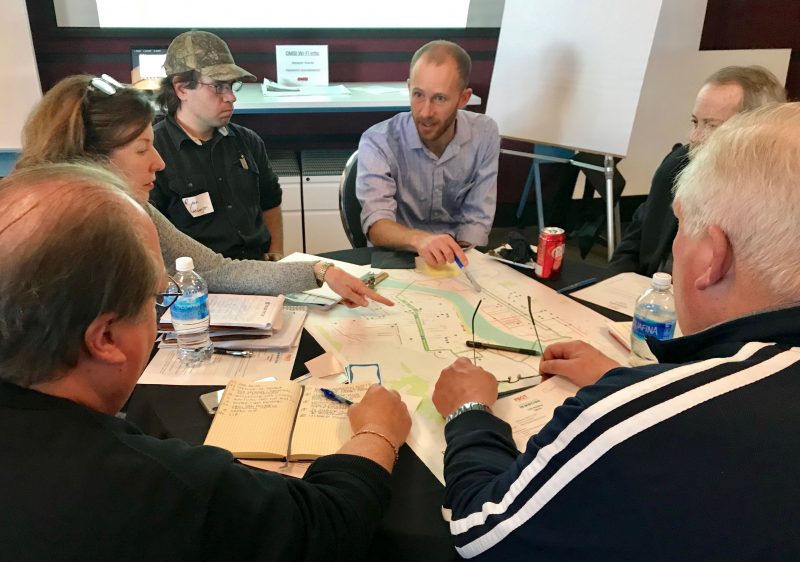
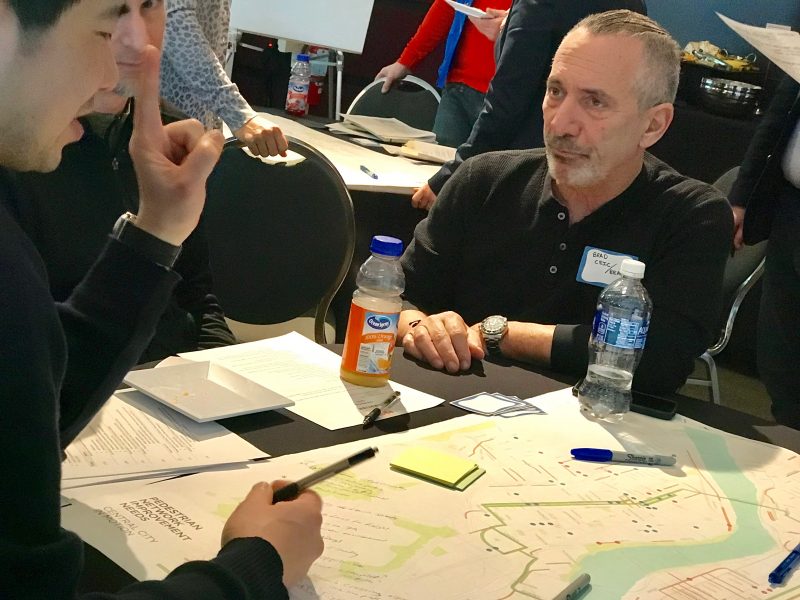
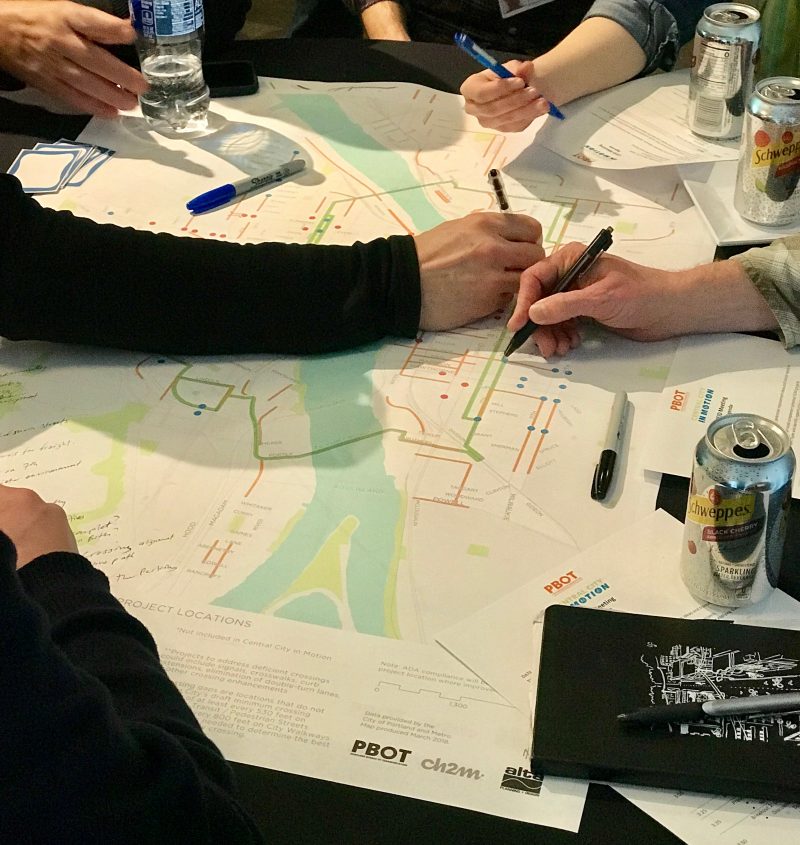
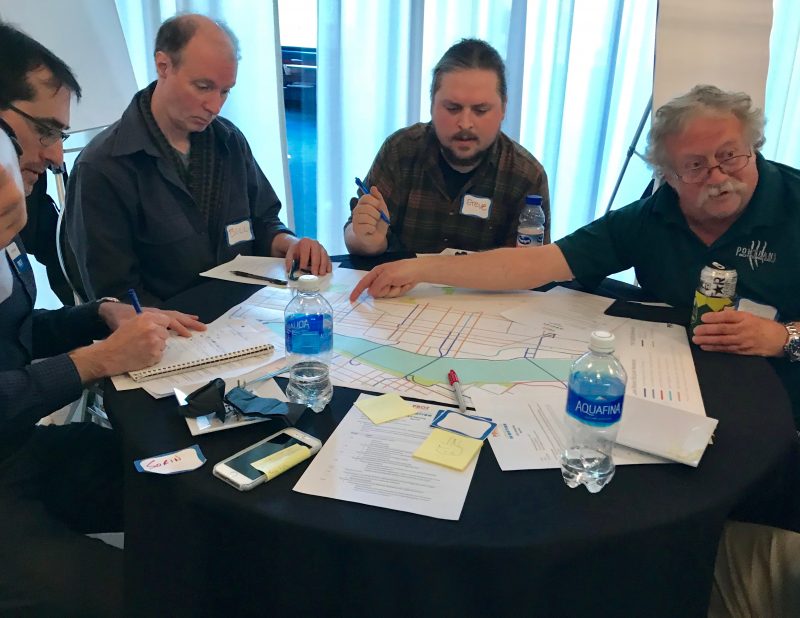
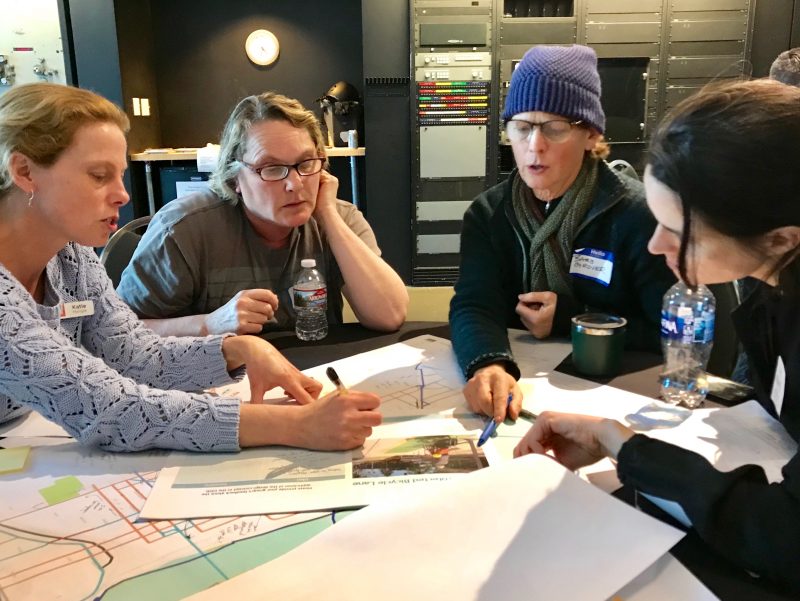
The Central Eastside — roughly defined as the area bordered by OMSI, the Willamette River, 12th Avenue and NE Multnomah (or so) — is a big target for PBOT. They understand it’s imperative that we create safer, more bikable, and human-scale streets in this area — but they also understand there are many entrenched interests that are wary of anything that will constrain freight or auto parking capacity. The heart of the CEID is a heavily industrial area that’s changing rapidly from freight-centric to office and residential uses. While this transition happens, the safety of mixing walkers and bicycle riders with large trucks also looms over these discussions.
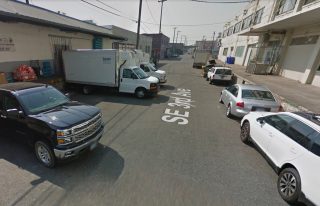
PBOT phrases their careful approach here as, “preserving the industrial character of the CEID.” But the tension among the staff, advocates, consultants and business owners in the room is about compromise. Who will have to give up what in order for the goals of the project to be reached?
At Wednesday’s meeting I heard an unexpectedly productive conversation. With CEIC bigwigs like Beam Development President Brad Malsin, New Seasons Market Director of Real Estate Lisa Lamanna, Portland Bottling Company VP Tom Keenan, and Franz Bakery Fleet Manager Mike Albrecht on hand, PBOT project manager Gabe Graff and Katie Mangle with Alta Planning steered breakout groups into a discussion that zeroed in on the specific streets where changes should be focused.
Also in the room were Central Eastside business owners like Barb Grover of Splendid Cycles, Charlie Wicker of Trailhead Coffee Roasters, Biketown General Manager Dorothy Mitchell, Clever Cycle Co-owner Eva Frazier, and others.
At the outset, Graff said PBOT’s goal is to “provide low-stress bikeways, prioritize tranit, and increase pedestrian safety in our central city.” “It’s a unique project for us,” he continued, “In that we have funding for the planning phase and to figure out where these projects should go — we hope to have that wrapped up by this summer — then we’ll have funding on the backend to deliver on those projects. So we can turn around immediately from these kind of planning exercises and go into design and construction.”
While there weren’t any votes or hard lines put on a map Wednesday, some themes emerged.
Former CEIC President and current member Peter Stark thinks it’s time to talk about the Martin Luther King Jr. Blvd and Grand Avenue couplet. “We currently have a misuse of the roadway. King/Grand shouldn’t be a drive-through for our district,” he said during one of the breakout sessions. “We need improvements to make that a safer place for people to shop, work and live.” Stark wasn’t the only one making the case for taming the MLK/Grand couplet. If the CEIC is to ever become a great place to walk and bike, the thinking goes, MLK/Grand must be addressed.
The future of 7th Avenue is likely going to be a big part of this debate. It’s the most direct and well-known north-south route in the Central Eastside — but freight interests can’t envision it as ever being a “family-friendly bikeway.” There was a lot of talk on Wednesday about how 7th compares and contrasts with 6th Avenue. Both of these streets have also been set aside as part of the possible future alignment of the Green Loop, which gives them added priority in PBOT’s planning hierarchy.
While 6th might be lower-traffic and easier to foresee (for some) as a “low-stress” route, it doesn’t connect as well to the existing system. 7th has also been chosen as the alignment for the forthcoming Sullivan’s Crossing Bridge.
Right now PBOT’s CCIM map doesn’t have any “desired link choices” between 7th and Water Ave. That’s seven blocks without a good bike north-south bike route. One possibility is to create an “industrial greenway” on 3rd; but as you can see in the map below, 3rd has intense freight usage.
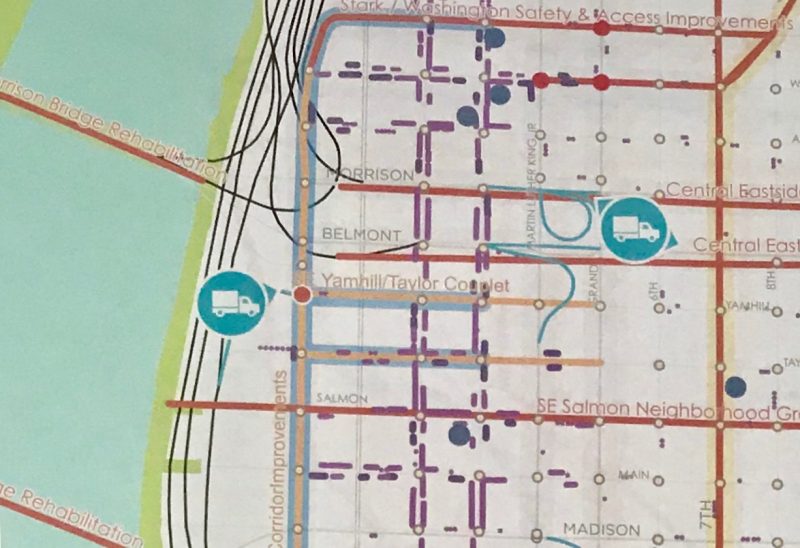
Regardless of which north-south streets get chosen, one Central Eastside Business owner, Steve Bozzone of Bozz Media, expressed concerns that PBOT is missing the key connections. Bozzone lives in north Portland and enters the District via the Oregon Convention Center. “We already missed an opportunity when Streetcar took a lane on MLK,” he said in a group discussion. He wants the project to improve access between the Convention Center and 3rd.
“We have bike lanes on many of the streets. What if we were to remove those and consolidate them on one or two blocks and make those streets dedicated for bikes?”
— Brad Maslin, Beam Development/CEIC
Water Avenue came up a lot on Wednesday. There was talk of making a two-way cycle-track on Water to relieve pressure on the Eastbank Esplanade (which several people said was anything but “low-stress” due to how “fast those bicyclists ride”). Water’s connection to the Hawthorne and Morrison Bridges make it a lynchpin in this plan and it’s safe to assume it’s not a matter of if it’s improved but how.
One cool idea I’d never heard of before: Connect Water Avenue directly to the Esplanade with a new path at SE Stark via an existing access road currently owned by ODOT.
Another over-arching theme of this Central Eastside discussion is whether it’s smarter to create just a couple very good bike streets, or if PBOT should spread the funding around to make most of the streets bike-able. “Is there any common sense to aggregating bike lanes,” Brad Malsin with Beam Development wondered out loud. “We have bike lanes on many of the streets. What if we were to remove those and consolidate them on one or two blocks and make those streets dedicated for bikes?”
That type of thinking could carry weight, given that PBOT has set a high bar for the type of conditions they want to create. Even project consultant Katie Mangle with Alta Planning + Design repeatedly said they can’t improve every street. “We’re looking for the minimum network we can do,” she said, “Because we want this to be something we can build in the next five years.”
By then, she added, we’ll have “A network that’s connected and coherent and designed for safety that can get kids and families and Central Eastside employees where they need to go around the district. It won’t be every street, but there will be a network and we’ll have it well-signed so you know how to get to the bridge to to downtown.”
That’s a very appealing vision. The question remains though: Does PBOT have the courage to push for it? Even in the face of opposition from the CEIC? Maybe these two private design meetings have calmed the CEIC’s nerves. Time will tell. I did find it noteworthy however, that the final word on Wednesday came from CEIC Community Engagement Director Kate Merrill, who ended the meeting by saying, “One thing we must always keep in the back of our minds is that freight is the backbone of our district.”
To which Mike Albrecht from Franz Bakery replied under his breath, “I’ll get you that $20 later.” Then everyone laughed.
Whether or not everyone’s still smiling at the end of this road remains to be seen.
Learn more about the Central City In Motion project on PBOT’s website. And stay tuned for the online open house to go live on Monday.
— Jonathan Maus: (503) 706-8804, @jonathan_maus on Twitter and jonathan@bikeportland.org
Never miss a story. Sign-up for the daily BP Headlines email.
BikePortland needs your support.



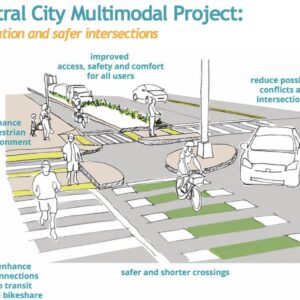
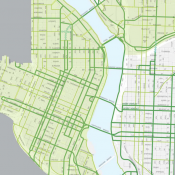
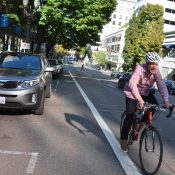

Thanks for reading.
BikePortland has served this community with independent community journalism since 2005. We rely on subscriptions from readers like you to survive. Your financial support is vital in keeping this valuable resource alive and well.
Please subscribe today to strengthen and expand our work.
I am a big fan of 6th ave as the n/s route through the CEID. I have worked in the CEID sine 2008 in 3 different spots and have commuted to and through year-round on a bike. ^th is closer to stuff on Grand/MLK, could easily be calmed by making a couple of blocks one-way to cars or adding diverters, and switch to 7th at Everett. 7th has 2 fatal flaws IMO. 1) the concept is a 2-way bikeway on one side of the street- this creates conflicts with the bikes traveling the “wrong way” at each intersection. This area gets a lot of visitors, tourists, etc- it would not be good. 2) Sandy dead-ends into 7th at the intersection of 7th/Washington and crossing it northbound is very sketchy.
I love the idea of connecting to the Eastbank form the intersection of Stark/water; I have also fantasized about extending 3rd north under the I-84 ramps and over the RR tracks to connect to LLoyd- check it out, it looks possible! I was disappointed to see the line along Ankeny across Sandy marked “complete”- that intersection sucks! Ankeny and Salmon need signals to cross Grand and MLK, and Salmon needs diverters between 11th and Grand.
Hi Jonathan,
Sorry you thought this meeting was a secret meeting! In developing our projects, we meet with a variety of stakeholders, oftentimes in small groups to have conversations focused on their particular interests. OMSI was kind enough to provide the meeting space, and their sign was intended to let visitors know that this was not an OMSI event, not to discourage you from attending. We will continue to engage the public with a variety of meetings and online engagement and input opportunities. The November 2017 presentation to our stakeholder committee, available on our web site, shows the public engagement coming up this year, including this month’s CEID engagement:
https://www.portlandoregon.gov/transportation/article/671700
Thanks for mentioning the online open house, which we expect to launch on Monday! Check the Central City In Motion project web site to stay up to date:
https://www.portlandoregon.gov/transportation/71158
Dylan
Dylan Rivera
PBOT Public Information Officer
Thanks for the comment Dylan,
The meeting wasn’t posted on the PBOT website and it was by invite-only. It’s also not mentioned in any detail in that Nov 2017 presentation you refer to. So technically, the meeting was secret to the public — because they had no way of knowing about it. I found out about it only because someone else who was going mentioned it to me and was surprised that it wasn’t more widely publicized.
Can you clarify what type of public engagement PBOT has done on this project thus far? Did I get that part right in my story? I’m only aware of the presentation to committees and organizations. I’m not aware of any meetings or open houses where the general public could have 1) known about it beforehand and 2) could offer feedback about the plan.
I understand meeting with stakeholders is important, it just feels like to me — and based on the history of this project so far — that there’s been a lot of substantive work done before the project is being opened up to the general public. That concerns me because the general public should have the same access to the decision-making process as powerful interests that PBOT works so closely with so often.
Thanks for leaving a comment about this. It’s important to be transparent.
I ride in the CEID daily on my regular N-S commute, but I’m not gonna say which streets I use because I don’t want PBOT messing with them.
But go ahead with 7th, that’s all fine by me!
Brad Malsin.
Yes. Fixed. Sorry for the error.
Blatant violation of the open meetings law.
Why do you believe that open meetings law requires public to be present when staff are meeting with people? To be subject to an open meeting law, there must be decision-makers present.
I nominate Buffy as public stakeholder.
These actual project updates are like crack
So glad to see some solid short-term plans. Hope some high-quality CEID bike lanes get built soon, wherever they are!
With vision like this, it’s no wonder PDX is stagnating/falling in terms of active transportation. Sure, make a small handful of streets work for people on bikes and perfect the rest for SOV’s and freight. What could go wrong? I’ll tell you: it will continue to spread the notion that bikes do not belong anywhere but in a few special places. That’s a recipe for failure, no matter the excuses for doing it.
How about we experiment with the other side of that coin. Let’s see what the absolute minimum network people using cars could manage with. Note I’m talking minimum, not perfect. Now let’s close every road and intersection that isn’t part of that minimum to cars. Hey, if making a tiny fraction of the road network functionally available for the preferred mode, cycling, is acceptable, then doing the same thing for the lowest priority mode should be a starting point.
I’m with you in spirit. The devil is the details. I’d love to put some boundaries on cars (and my current business model is strangely car-dependent.) It’s going to be a big job politically to make the changes you suggest. In the meantime let’s put in more diverters that are bike permeable, calling them anything but diverters. Hide the agenda! Say you’re giving a block away to a multinational corporation or something (not the art museum) but keep a right-of-way for people.
This process is going to present the public with a fait accompli. A design that has been determined by a small group of important and connected persons, business groups, and financially involved industries. PBOT will use its PR and graphics resources do a full court sales job to the general public. The public will be given an online poll of leading questions. The answers that support the pre-determined design will be highlighted. And the project will go forward in the manner that was decided in these closed door meetings, with a few little tweaks maybe.
We’ve seen this done by the city in various projects from transportation to land use and other areas too. Public input is treated as a hurdle to be surmounted, rather than actually sought out and respected, because the experts and central planners know best.
Many commenters on BP have complained about PBOT listening to neighborhood or other public voices, and have called for PBOT to simply jam projects forward without all that irritating listening to the public. So it shouldn’t be too surprising that this is going to be done more and more. The shoe will just be on the other foot.
This is PBOTs MO, the public process is only there to support and reinforce PBOTs ‘prefered alternative’.
If PBOT rammed things through in a reasonable amount of time, I would be fine with that assuming those “things” were steps forward. Taking 6 or 7 years procrastinating on coming up with a fait accompli proposal to “ram through” is the worst of both worlds.
Neighborhood Associations are another anti-democratic stakeholder group.
I remain fairly amazed that platinum bicycle city Portland doesn’t have a protected bike network through the central city. But in the mean time, why not paint sharrows on most/all downtown streets? Traffic doesn’t move that fast in downtown and sharrows encourage cyclists to take the lane (in my experience anyway.) It’s a much better alternative than riding in the door zone.
That would be too practical. HBTP included this as a recommendation but PBOT bailed on implementation.
One of the few things that Eugene has done right over the past decade has been the recent placement of sharrows on many downtown streets. They even placed them properly well clear of the door zone. It’s been wonderful to have motorists who are clearly getting agro suddenly calm down when we roll over the sharrow markings.
Sharrow doubter here. If a stop sign, the least ambiguous traffic control device going, doesn’t protect bike right-of-way on a NE greenway, what’s a sharrow going to do?
Jonathon, “stakeholder” is a euphemism for “special interest group.”
Using it is only a convenient cover for governmental entities to shut out the public from crucial decision making.
This is a nefarious practice that can have no honor in our discourse.
In its best sense, “stakeholder” applies to people most directly impacted by proposed changes, for good or ill. If plans were proposed to alter the street on which you live, you’d have a greater stake in that change than someone from another part of town. If that makes you a “special interest group,” then so be it.
A government must sometimes resort to running roughshod over local interests in the name of the greater good, but a responsive government goes the extra mile to minimize that sort of intervention.
Was any data presented on freight movement and volume over the last 10 years in CEID? My guess would be that it is trending downward as the knowledge economy takes over, especially in the CEID. see Joe Cortright’s work. “Freight” is used in this town as an excuse to widen roads, widen lanes, and generally waste money on roads that would be better spent on more transit and safer biking and walking. The obstacle to moving freight, whether its in the CEID, on Swan Island or I-5 is too many folks driving alone in the cars; give them safe, reliable options and enough will leave their cars at home to make room for what freight movement there remains.
How about making some CEID streets into Dutch-style bike/ped streets where trucks and cars are “guests” restricted to moving 20 kph (14 mph)? Given that most heavy trucks and semis are moving slowly for deliveries anyway, would it be such a burden for the CDL drivers?
Trying to preserve the CEID and protect it from gentrification/redevelopment is a fool’s mission, it’s going to happen at some point.
Fine investigative journalism, JM
Few people take the time and energy to do this, these days.
N-S Bikeways should also be considered on the 11/12th Ave couplet: these streets need to have one car lane removed and one lane for transit/bike dedicated only. From Clinton to Burnside with strong connections to the new sullivan’s gulch bridge.
I will continue to ride them by taking the lane, especially southbound on 11th, and encourage others to join me.
Is it reasonable to say that designating a street for people, as opposed to motor vehicles, creates wealth for property owners on the street? Of course for this to work you need either functional transit or parking garages. Parking garages for bikes? We already know that bike corrals create retail traffic.
I won’t hold my breath on seeing this project complete. PBOT really needs some fresh professionals/perspectives from other places with a proven track record of actually implementing world class transportation facilities. We can reasonably forecast that the outcome will have mixed reviews based on past performances. Did it really need to take 8-10 years to get there? We have long known what tools can be used to improve cycling safety. Although the City spend $100Ks on planning, it’s the escalation cost of construction that is really biting into this and so many other projects that sit on the planning back burner.
Portland is following a very dangerous trend in neoliberal urbanism, which posits “the livable city” as consumer good,homogenized to meet “consumer demand” until public policy becomes almost motionless, certainly reduced in quality and bordering in the banal. Buy-in from local business sector dominates policy conversations and civic innovation is reduced to ROI rather than quality of human life. It’s rather unremarkable from a standpoint of global competitiveness and, I’d argue, beneath us. “The People’s Republic of Portland” can and should do better.
P.S. They should rename the project ‘white people in motion’ because that’s the only skin color I see in that room, jus sayin.
My take away from the meeting is that there is a long list of user groups with different needs. Trying to solve this isn’t easy. If one assumes, *just* as a thought exercise, that pbot is attempting to do the very best to find a solution, then maybe the realization that it’s not easy will emerge. Do I want more progress, faster? Yes! Does my business benefit in both safety and efficiency from well thought out cycling infrastructure? Absolutely! In fact, a key focus and intent of the whole endeavor is to show the viability of delivery by cargo bike as a solid business model. Anyway, while there’s truth to some of the above complaints, I for one am grateful that they are focusing on these tasks.
Has anyone talked to B-Line Delivery about freight movement in the area? They would be an great partner in any effort to reduce the number of large trucks in the District and make smaller connections through the region. They are located in the Central Eastside and have proven that their delivery model works. This is a huge opportunity for the Central Eastside to do something different.
Hi Rachel. B-Line Delivery owner Franklin Jones is actively involved in this planning process. He was at the meeting covered in the story. And PBOT definitely “bicycle freight” on their radar.